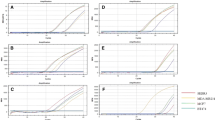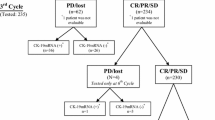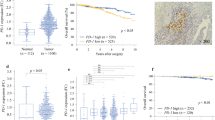Abstract
In order to investigate the prognostic value of circulating tumor cells (CTCs) in patients with metastatic breast cancer (MBC), the blood cells from 98 MBC patients and 60 controls were evaluated by RT-PCR to detect the presence of markers EpCAM, CK19, and hMAM. Peripheral blood was obtained from all patients with MBC before any systemic therapy. Immunofluorescence staining experiment was conducted on CTCs samples from 10 patients to investigate the coexpression of EpCAM, CK19, and hMAM. In addition, analyses were carried out for their correlation with patients’ clinicopathologic features. EpCAM+, CK19+, and hMAM+ cells were detected in 50 (51.0 %), 43 (43.9 %), and 68 (69.4 %) of the 98 patients, respectively. Triple-marker-positive CTCs were detected in 86 of 98 (87.8 %) patients with a significantly higher rate than the control group. Among the 98 patients, 12 (12.2 %) patients were negative for three genes, 34 (34.7 %) positive for one gene, 29 (29.6 %) positive for any two genes, and 23 (23.5 %) positive for all three genes. Compared to single-marker detection, the triple combined marker detection exhibited significantly higher rate. Furthermore, the specificity of triple combined markers of serial test was 100 %. The expression of three genes was significantly correlated with lymph node metastasis, high histological grade, and high levels of serum CA153 and CEA. Double-immunofluorescence labeling confirmed the presence of following CTCs phenotypes: CK19+/hMAM+, CK19+/hMAM−, CK19−/hMAM+, CK19+/EpCAM+, CK19−/EpCAM+, CK19+/EpCAM−, hMAM+/EpCAM+, and hMAM+/EpCAM−. After 2 years of follow-up, the presence of CTCs with triple-marker positive in peripheral blood was an independent risk factor for reduced progression-free survival (PFS) and overall survival (OS), and the presence of CTCs before any chemotherapy predicts poor OS and PFS in patients with MBC.



Similar content being viewed by others
References
Pantel, K., & Brakenhoff, R. H. (2004). Dissecting the metastatic cascade. Nature Reviews Cancer, 4, 448–456.
Slade, M. J., & Coombes, R. C. (2007). The clinical significance of disseminated tumor cells in breast cancer. Nature Clinical Practice Oncology, 4, 30–41.
Lacroix, M. (2006). Significance, detection and markers of disseminated breast cancer cells. Endocrine-Related Cancer, 13, 1033–1067.
Ignatiadis, M., Georgoulias, V., & Mavroudis, D. (2008). Circulating tumor cells in breast cancer. Current Opinion in Obstetrics and Gynecology, 20, 55–60.
Stathopoulou, A., Vlachonikolis, I., Mavroudis, D., et al. (2002). Molecular detection of cytokeratin-19-positive cells in the peripheral blood of patients with operable breast cancer: evaluation of their prognostic significance. Journal of Clinical Oncology, 20, 3404–3412.
Jotsuka, T., Okumura, Y., Nakano, S., et al. (2004). Persistent evidence of circulating tumor cells detected by means of RT-PCR for CEA mRNA predicts early relapse: a prospective study in node-negative breast cancer. Surgery, 135, 419–426.
Pierga, J. Y., Bonneton, C., Vincent-Salomon, A., et al. (2004). Clinical significance of immunocytochemical detection of tumor cells using digital microscopy in peripheral blood and bone marrow of breast cancer patients. Clinical Cancer Research, 10, 1392–1400.
Benoy, I. H., Elst, H., Philips, M., et al. (2006). Real-time RT-PCR detection of disseminated tumour cells in bone marrow has superior prognostic significance in comparison with circulating tumour cells in patients with breast cancer. British Journal of Cancer, 94, 672–680.
Ashworth, T. R. (1869). A case of cancer in which cells similar to those in the tumours were seen in the blood after death. Australian Medical Journal, 14, 146–149.
Van der Auwera, I., Peeters, D., Benoy, I. H., et al. (2010). Circulating tumour cell detection: a direct comparison between the cell- search system, the AdnaTest and CK-19/mammaglobin RT-PCR in patients with metastatic breast cancer. British Journal of Cancer, 102, 276–284.
Bosma, A. J., Weigelt, B., Lambrechts, A. C., et al. (2002). Detection of circulating breast tumor cells by differential expression of marker genes. Clinical Cancer Research, 8, 1871–1877.
Ring, A. E., Zabaglo, L., Ormerod, M. G., et al. (2005). Detection of circulating epithelial cells in the blood of patients with breast cancer: comparison of three techniques. British Journal of Cancer, 92, 906–912.
Cimino, A., Halushka, M., Illei, P., et al. (2010). Epithelial cell adhesion molecule (EpCAM) is overexpressed in breast cancer metastases. Breast Cancer Research and Treatment, 123, 701–708.
Saloustros, E., & Mavroudis, D. (2010). Cytokeratin 19-positive circulating tumor cells in early breast cancer prognosis. Future Oncology, 6, 209–219.
Roncella, S., Ferro, P., Bacigalupo, B., et al. (2006). Relationship between human mammaglobin mRNA expression in breast cancer tissue and clinico-pathologic features of the tumors. Journal of Experimental & Clinical Cancer Research, 25, 65–72.
Span, P. N., Waanders, E., Manders, P., et al. (2004). Mammaglobin is associated with low-grade, steroid receptor-positive breast tumors from postmenopausal patients, and has independent prognostic value for relapse-free survival time. Journal of Clinical Oncology, 22, 691–698.
Zach, O., Kasparu, H., Krieger, O., et al. (1999). Detection of circulating mammary carcinoma cells in the peripheral blood of breast cancer patients via a nested reverse transcriptase polymerase chain reaction assay for mammaglobin mRNA. Journal of Clinical Oncology, 17, 2015–2019.
Ignatiadis, M., Kallergi, G., Ntoulia, M., et al. (2008). Prognostic value of the molecular detection of circulating tumor cells using a multimarker reverse transcription-PCR assay for cytokeratin 19, mammaglobin A, and HER2 in early breast cancer. Clinical Cancer Research, 14, 2593–2600.
Mikhitarian, K., Martin, R. H., Ruppel, M. B., et al. (2008). Detection of mammaglobin mRNA in peripheral blood is associated with high grade breast cancer: interim results of a prospective cohort study. BMC Cancer, 8, 55–65.
Osta, W. A., Chen, Y., Mikhitarian, K., et al. (2004). EpCAM is overexpressed in breast cancer and is a potential target for breast cancer gene therapy. Cancer Research, 16, 5818–5824.
Stathopoulou, A., Gizi, A., Perraki, M., et al. (2003). Real-time quantification of CK-19 mRNA-positive cells in peripheral blood of breast cancer patients using the lightcycler system. Clinical Cancer Research, 9, 5145–5151.
Xenidis, N., Perraki, M., Kafousi, M., et al. (2006). Predictiveand prognostic value of peripheral blood cytokeratin-19 mRNA-positive cells detected by real-time polymer-ase chain reaction in node-negative breast cancer patients. Journal of Clinical Oncology, 24, 3756–3762.
Xenidis, N., Vlachonikolis, I., Mavroudis, D., et al. (2003). Peripheral blood circulating cytokeratin-19 mRNA-positive cells after the completion of adjuvant chemotherapy in patients with operable breast cancer. Annals of Oncology, 14, 849–855.
Hongbo, L., Xiaohui, L., Hong, K., et al. (2007). Assessing routine and serum markers of liver fibrosis in CHB patients using parallel and serial interpretation. Clinical Biochemistry, 40, 562–566.
Paterlini-Brechot, P., & Benali, N. L. (2007). Circulating tumor cells (CTCs) detection: clinical impact and future directions. Cancer Letters, 253, 180–204.
Cristofanilli, M., Budd, G. T., Ellis, M. J., et al. (2004). Circulating tumor cells, disease progression and survival in metastatic breast cancer. New England Journal of Medicine, 351, 781–791.
Tewes, M., Aktas, B., Welt, A., et al. (2009). Molecular profiling and predictive value of circulating tumor cells in patients with metastatic breast cancer, an option for monitoring response to breast cancer related therapies. Breast Cancer Research and Treatment, 115, 581–590.
Zhao, S., Liu, Y. P., Zhang, Q. Y., et al. (2011). The prognostic role of circulating tumor cells (CTCs) detected by RT-PCR in breast cancer: a meta-analysis of published literature. Breast Cancer Research and Treatment, 130, 809–816.
Watson, M. A., & Fleming, T. P. (1996). Mammaglobin, a mammaryspecific member of the uteroglobin gene family, is overexpressed in human breast cancer. Cancer Research, 56, 860–865.
Chen, Y., Zou, T. N., Wu, Z. P., et al. (2010). Detection of cytokeratin 19, human mammaglobin, and carcinoembryonic antigen-positive circulating tumor cells by three-marker reverse transcription-PCR assay and its relation to clinical outcome in early breast cancer. International Journal of Biological Markers, 2, 59–68.
Androulakis, N. E. M., Perraki, M., Apostolaki, S., et al. (2011). Clinical relevance of circulating CK-19mRNA-positive tumor cells at first diagnosis in patients with metastatic breast cancer. Journal of Clinical Oncology, 29, abstr 10553.
Strati, A., Markou, A., & Parisi, C. (2011). Gene expression profile of circulating tumor cells in breast cancer by RT-qPCR. BMC Cancer, 11, 422–433.
Shen, C. X., Hu, L. H., Xia, L., et al. (2009). The detection of circulating tumor cells of breast cancer patients by using multimarker (Survivin, hTERT and hMAM) quantitative real-time PCR. Clinical Biochemistry, 42, 194–200.
Chen, C. C., Chang, T. W., Chen, F. M., et al. (2006). Combination of multiple mRNA Markers(PTTG1, Survivin, UbcH10 and TK1) in the diagnosis of Taiwanese patients with breast cancer by membrane array. Oncology, 70, 438–446.
Ferro, P., Franceschini, M. C., Bacigalupo, B., et al. (2010). Detection of circulating tumour cells in breast cancer patients using human mammaglobin RT-PCR: association with clinical prognostic factors. Anticancer Research, 30, 2377–2382.
Marques, A. R., Teixeira, Elsa., Diamond, Joana., et al. (2009). Detection of human mammaglobin mRNA in serial peripheral blood samples from patients with non-metastatic breast cancer is not predictive of disease recurrence. Breast Cancer Research and Treatment, 114, 223–232.
Grünewald, K., Haun, M., Urbanek, M., et al. (2000). Mammaglobin gene expression: a superior marker of breast cancer cells in peripheral blood in comparison to epidermal-growth-factor receptor and cytokeratin-19. Laboratory Investigation, 80, 1071–1077.
Daskalaki, A., Agelaki, S., Perraki, M., et al. (2009). Detection of cytokeratin-19 mRNA-positive cells in the peripheral blood and bone marrow of patients with operable breast cancer. British Journal of Cancer, 101, 589–597.
Ignatiadis, M., Xenidis, N., Perraki, M., et al. (2007). Different prognostic value of cytokeratin-19 mrna–positive circulating tumor cells according to estrogen receptor and HER2 status in early-stage breast cancer. Journal of Clinical Oncology, 25, 5194–5202.
Brandt, B., Roetger, A., Heidl, S., et al. (1998). Isolation of bloodbored epithelium-derived c-erb-B2 oncoprotein-positive clustered cells from the peripheral blood of breast cancer patients. International Journal of Cancer, 76, 824–828.
Wulfing, P., Brochard, J., Buerger, H., et al. (2006). HER2 positive circulating tumor cells indicate poor clinical outcome in stage I to III breast cancer patients. Clinical Cancer Research, 12, 1715–1720.
McShane, L. M., Altman, D. G., Sauerbrei, W., et al. (2005). Reporting recommendations for tumor marker prognostic studies (REMARK). Journal of the National Cancer Institute, 97, 1180–1184.
Harris, L., Fritsche, H., Mennel, R., et al. (2007). American Society of Clinical Oncology 2007 update of recommendations for the use of tumor markers in breast cancer. Journal of Clinical Oncology, 25, 5287–5312.
Acknowledgments
This experiment was performed in the Oncobiology Key Lab of the Heilongjiang Province Common Institution of Higher Learning. This work was supported by the National Natural Science Foundation of China [grant number 81071889] and Harbin science and technology innovation talents research special funds [grant number 2011RFXYS060].
Conflict of interest
All authors declared that there is no conflict of interest.
Author information
Authors and Affiliations
Corresponding author
Additional information
Shu Zhao and Huike Yang contributed equally to the work.
Rights and permissions
About this article
Cite this article
Zhao, S., Yang, H., Zhang, M. et al. Circulating Tumor Cells (CTCs) Detected by Triple-Marker EpCAM, CK19, and hMAM RT-PCR and Their Relation to Clinical Outcome in Metastatic Breast Cancer Patients. Cell Biochem Biophys 65, 263–273 (2013). https://doi.org/10.1007/s12013-012-9426-2
Published:
Issue Date:
DOI: https://doi.org/10.1007/s12013-012-9426-2




